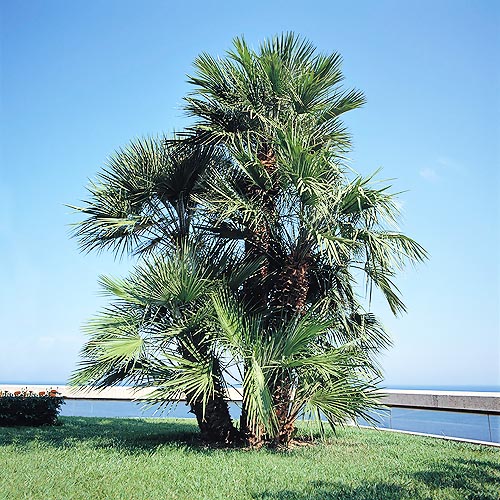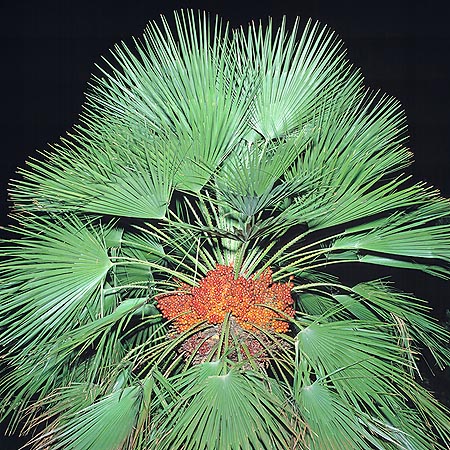Family : Arecaceae

Text © Pietro Puccio

English translation by Mario Beltramini

The Chamaerops humilis is a Mediterranean palm © Giuseppe Mazza
The name of the genus comes from the Greek “chamai” = on the ground, and “rhops” = bush; the name of the species comes from the Latin “humilis” = low. Both refer to the appearance of the plant.
Known in Italy as palma nana, palma di San Pietro, it is called in Sicily ciafagghiuni, giummarra, scuparina, scupazzu; in Sardinia: margaglio’, pramma, paimmizzu; in Spain: Palma de escobas, Palma de palmitos, Palmera enana; in Portugal: Palmeira ana, Palmeira das vasouras; in France: Chamérops humble, Palmier nain, Palmite nain; in Germany: Zwergpalme and in the English-speaking countries: Dwarf fan palm, and Palm cabbage. It is a species which is extremely variable in appearance, colour and shape of the leaves.
Usually, it has a bushy appearance, with stems, of about 15-20 cm of diameter, covered by a brown fibre and by the petioles of the dried up leaves. Stems which generally keep low, but which can reach, under optimal conditions, the 6-8 metres of height. The leaves are palmate, rather rigid, and almost circular, of about 60 cm of diameter, of pale green colour on the upper side, and with a whitish waxy bloom on the lower one, with several forked segments in the apical part. The petioles, long even more than one metre, are equipped with strong thorns along the margins.
It is a dioecious plant, but there are specimen, although rare, with hermaphrodite flowers; the short inflorescences, much ramified, carry flowers with a deep yellow colour. The ovoid fruits, 1-2 cm long, have a colour varying from orange to brown. It multiplies by seed, which germinates in about two months, and, with some difficulty, by division.

Chamaerops humilis with fruits © Giuseppe Mazza
Synonyms : Chamaerops arborescens (Pers.) Steud. (1821) ; Chamaerops conduplicata J.Kickx f. (1838); Chamaerops depressa Chabaud (1915); Chamaerops elegans Hook.f. (1884); Chamareops humilis var. dactylocarpa Becc. ex Martelli (1889); Chamaerops humilis var. decipiens Becc. (1920); Chamaerops humilis var. depressa Mart. (1838); Chamaerops humilis var. elata Mart. (1838); Chamareops humilis var. hystrix Becc. (1920); Chamaerops humilis f. inermis Regel ex Becc. (1920); Chamaerops humilis var. lusitanica Becc. (1920); Chamaerops humilis subvar. macrocarpa (Tineo) Nyman, Consp. (1882); Chamaerops humilis var. macrocarpa (Tineo) Nyman, Consp. (1890); Chamaerops humilis f. mitis Maire & Weiller (1957); Chamaerops humilis var. sardoa Becc. (1920); Chamaerops humilis var. sicula Becc. (1920).
→ For general notions about ARECACEAE please click here.
